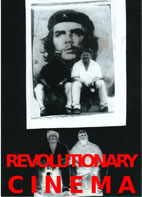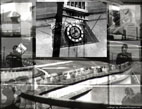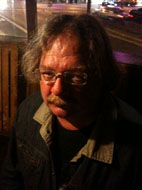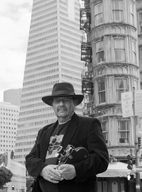Dominic Angerame
"To see the city through the eyes of Dominic Angerame is to see an organic beast of concrete that sifts and breathes in rich shades of black and white." --Silke Tudor, SF Weekly
Since 1969, Dominic Angerame has made more than 35 films that have been shown and won awards in film festivals around the world. He has also been honored by two Cine Probe Series at the Museum of Modern Art in New York City -- in 1993 and in June 1998.
Anaconda Targets (2004) was exhibited at the Whitney Biennial (2006).
Dominic Angerame presented his "City Symphony Series" along with Pixiescope, Waifen Maiden, Consume, and Anaconda Targets at the Havana Film Festival (Festival International del Nuevo Cine Latinamericano) 2006. This was the first time experimental cinema has been presented at this festival during the past 28 years.
His film The Soul of Things (2010) has been shown at the San Francisco International Film Festival, Onion City Film Festival, Toronto International Film Festival, New York Film Festival and the Viennale Film Festival.
Angerame teaches filmmaking/cinema studies/criticism the San Francisco State Downtown Center, University of California, Berkeley Extension, the San Francisco Art Institute as a visiting artist. He has also taught film production and cinema studies at the University of California Berkeley, Extension, New College of California; and has been a guest lecturer and visiting artist for Stanford University, the School of the Art Institute of Chicago, the Graduate School of Theology in Berkeley, and others.
Dominic Angerame had been the Executive Director of Canyon Cinema from 1980-2012. Canyon Cinema's contribution to the field of experimental/avant garde filmmaking is historic and heroic.
For his filmmaking projects, Angerame has been awarded film productions grants from The Illinois Arts Council; Samuel B. Mayer Foundation; three grants from the National Endowment for the Arts Western Regional Fellowships, The Film Arts Foundation. In the Spring of 1999 Mr. Angerame curated a series of fourteen film programs for the San Francisco Museum of Modern Art. This extremely successful series was called SHAKE THE NATION and traced the development of avant garde filmmaking in San Francisco from 1939 to the present. Mr. Angerame has been nominated for a John D. Rockefeller Foundation Grant in Filmmaking for the year 2000. Dominic's film "In the Course of Human Events" (1997) of a group exhibition held at the Fondation Cartier in Paris from November 2002 through March 2003 entitled "Ce Qui Arrive" curated by noted urbanist Paul Virilio.
Dominic was a guest artist in South Korea for the 50th anniversary of the creation of DMZ in 2005 and he has recently had major film retrospectives at the Univeristy of Illinois, Carbondale, the Viennale Film Festival in Vienna, and the Havana Film Festival in Cuba, and member of panel discussions regarding cinema in Barcelona, Spain. He has had complete retrospectives at the Vienalle Film Festival in Austria, and Mer del Plata Film Festival in Argentina. He travels to Cuba yearly to present a series about the history of avant garde in the United States from 1930's to the present.
The City, Refuse, Passion, and Death: On the Work of Filmmaker Dominic Angerame
by Stefan Grissemann
Since the 1960s, the American filmmaker, theorist, and avant-garde activist Dominic Angerame has been working in a form that is both documentary and poetic, an aesthetic alliance between realism and fantasy. He employs a variety of techniques, but his films are invariably and primarily concerned with basic problems of rhythm: the nervousness of the montage in almost all Angerame films stands in startling contrast to the gentleness of its effect on the viewer. The double and triple exposures this artist prizes so much brake, as it were, the quick pulse of his cuts and help them to achieve a peculiarly delicate quality.
Dominic Angerame's works search for unfamiliar views of seemingly familiar things: cities, landscapes, faces, and bodies. The filmmaker's desire to make everyday images "strange" at the editing table, to learn to see them fresh and to estrange them from our senses, makes his films seem-in all the different social realities they contain-always distanced as well, as if they led to another world beyond the concrete, beyond time and defined space. In Angerame's films, which pay homage to films from early cinema and the classic avant garde to American underground films of the 1960s and 70s and non-narrative films of the present day, an amazingly comprehensive history of the "visionary" moving image is always present. It may be that precisely his refusal to adopt a signature style has diminished the immediate influence of Angerame's films; however, Angerame's decision to work "universally," not to be swayed by considerations of the art market, and to experiment with very different styles increases the pedagogical worth of his films. It's not surprising to learn that Angerame, born in 1949, teaches at several American schools in addition to being the executive director of the American avant garde distribution center Canyon Cinema. His films testify to an encyclopedic knowledge of film-and also his desire to satisfy, with his own audio-visual offerings, the very different desires of his audience.
The concept "experimental film," by the way, doesn't fit Dominic Angerame. It sounds, he says, like it's just an attempt, as if he didn't know exactly what he was doing. His practical work in film is informed by essentially one principle: the renunciation of "narrative form." That alone seems enough to isolate a visual talent like his for a long time. Dominic Angerame is a marginalized filmmaker. The large digital movie databases don't even know his name.
I. City
His own films are "like city symphonies," Angerame explains lapidarily, "big-city landscapes in high-contrast black and white." This alludes to only one (but nevertheless important) part of Angerame's oeuvre: his five-part City Symphony, made between 1987 and 1997, the title of which is derived from the famous 1927 Walter Ruttman film Berlin: Symphony of a Big City, and which formally stands in the tradition of Dziga Vertov's urban-industrial montage. Angerame's city films show (urban) destruction and (cinematic) construction as two sides of the same coin: as de-construction even. To see the city through Angerame's eyes, writes Silke Tudor, is "to see an organic beast of cement that seems to breathe in rich shades of black and white."
The first of the City Symphony films is an Angerame masterpiece. Continuum deals in complete immediacy, with the play of light and shadow on cement surfaces, streets, houses, and bridges, but it deals also with the work performed on these sites: steel frames full of busy welders gleam in the blazing sun, house facades are cleaned and sand blasted, streets are tarred and strewn with shimmering gravel. There's wiping, spraying, cooking, shaking, and painting: Angerame shows us a world at work, in transformation-and, at the same time, he brings out the hierarchies implicit in that world: proletariat and industry, above and below. The workers remain anonymous, and the masks they wear emphasize their lack of identity. Nowhere else is Angerame's virtuoso editing technique, celebrated by Stan Brakhage for its "seeming lightness, which is so difficult to achieve," more apparent than in Continuum.
If one knew nothing of their history, it would be virtually impossible to date Angerame's films. There's a decidedly timeless quality to the City Symphony's subject matter and black and white material (and also to Angerame's partially manual film techniques). There's an urban, utopian mood in Continuum that would fit just as well in the late 1930s as it does in the late 1980s.
Angerame's city works untiringly probe the textures that present themselves to his camera: they show patterns and inscriptions on walls and metal surfaces, focus on fissures in cement, lose themselves in shadowy passers-by and smoke rising out of machines. By stylizing the urban everyday, Angerame translates it back into its emblematic quality in a series of astonishing signs. His film language follows-as in the fundamental cinematographic dramatization of white (sun) and black (tar) in Continuum, for example-a strict sensual order.
Premonition (1995) and In the Course of Human Events (1997) are cinematic twin stars that illustrate Angerame's construction/destruction philosophy most clearly. The first film captures for one last time on film the emptied Embarcadero Freeway in San Francisco, which was damaged beyond repair in the 1989 earthquake, right before it was torn down. Angerame sees Premonition as a "daydream," as a melancholic preview (and at the same time a continuous cinematic review) of an unstoppable annihilation. This film is, according to the director, "like the memory of something that has yet to take place." In the Course of Human Events is also constructed as an elegy: a tragedy of annihilation, a documentation of the demolition of the Embarcadero Freeway.
Similar to the filmmaker Peter Hutton, Angerame stylizes his urban landscapes into half-abstract, extremely painterly compositions. The ghostly calm that hovers over Premonition and the intense interest in construction details are reminiscent of the austere architecture films of Heinz Emigholz. Angerame films buildings, streets, and the construction of bridges by making them visually dynamic and rendering them strange in a sketchily, futuristic way: they become cinematic science non-fiction. In Premonition the camera traces curves in the street and the lines of metal bridge struts in both wide shots and close-ups, creating the impression of a seemingly omnipresent camera in the film's jumps between wide-angle shots and close-ups. Small details of movement break out of the unmoving, solidified world of this film: the wind blows a piece of paper over the street; two men pause far away at the water's edge; buildings are mirrored in an imperceptibly trembling water surface.
The hyperrealistic soundtrack that Angerame employs in Premonition is calculated to irritate: the cries of seagulls, a car alarm, a flag flapping in the wind-these are all infused with a sense of the unreal. Moreover, Angerame's soundscapes-and not only in this film-tend to a create synthetic, musical effects and heighten his films' pathos-filled moods.
Angerame's oeuvre is rich with antitheses to the City Symphony. The early El Train Film, for example, autobiographically motivated and already employing an advanced editing technique, deals with the utopia of continuous movement, of life as a journey. In the mid-1970s, Angerame relates, he lived in northern Chicago right by the tracks, where he could always hear the trains: "One could say they defined our life." Accompanied by a delicate old folk song, Angerame's El Train Film collects shots out moving trains and of the oncoming rails that cut through the wide, empty landscape in the sun: cinema as an awareness of life, as an expression of a lost counter-culture.
II. Refuse
The dilapidated, the ruined, and the thrown-away play a major role in Angerame's cinema. One can always make a film out of a pair of disposable objects. With his 1984 film Hit the Turnpike!, Angerame experiments with an autobiographically ironic variation on the song "Hit the Road Jack": the three-minute clip compiles in quick succession fragments of euphemistically formulated rejection letters, regretful replies, and negative reviews. Angerame productively uses the detritus of his filmmaker correspondence in a moving collection of cryptic signs, signatures, and logos. In Battle Stations-A Navel Adventure (2001), one of the filmmaker's most hermetic works, Angerame has his friend Leyna d'Ancona, dressed in a sequin top, perform a belly dance in a public space before the San Francisco Cinematheque in the harbor of Hunter's Point. He then projects onto her body images from the location-not only artist studios, a train museum, and a police laboratory, but also of the largest toxic waste dump in the city. In this ambience of shipyard work and industrial and possibly radioactive waste, Angerame creates a kind of music video in which all manner of strange and even improvised documentary events take place. The filmmaker Bruce Conner, for example, crosses the harbor's forbidden area with a Geiger counter and measures the level of radiation in the danger zone. They found, Angerame writes in the notes to the film, no traces of radioactivity in their measurements.
III. Passion
One could call Consume a partner film to Battle Stations (the artist himself uses the term "passion" for both films). Angerame's experiment with stroboscopic cinema, a kind of trance film inspired by Theodore Roszak's novel Flicker, interweaves eroticism and orientalism anew in the ecstatic performance of a dancer (Zhanna Kleiman) before the camera. Kleiman is exposed naked in the flickering light, percussive composition, and Angerame's frenetic montage, which merges its protagonist (literally from top to bottom) into a vision that flows seamlessly from the concrete to the abstract and back into the concrete. This montage layers the ritualistic movement studies of the heroine's body within each other so that they attain an artificial, graphic quality.
Cinematic speed is not the least of Angerame's many passions. In A Ticket Home (1982) he works so quickly with concrete images that they morph into partial abstractions. There's a droning in this film similar to that in the films of Dietmar Brehms, like the sound of far-off traffic, and quiet voices seem to be singing some strange song; a vague unease settles in. The film fastens onto figures and details: faces and wet streets, a pregnant woman, graffiti and people in an office; the flickering lane line of a highway, the sparkling of water. Angerame's films are simultaneously banal and charged, familiar and full of secrets. They offer a phenomenology of the everyday. The filmmaker's view is everywhere at once: in living rooms, above the clouds, in the bustle of the city, and in open nature. Angerame's film poems are impressionistic, volatile, always-changing.
Angerame experimented a lot in his early work, some of which proved to be a dead end. Scratches, Inc. (1975) indicates directions the filmmaker would not pursue later. This short work sets an abstract scratch animation, in the tradition of Len Lyes and Robert Breers, to an atonal soundtrack that's just as scratched as the image. Scratches, Inc. is a dance of white lines and points of light on a black field: a painting of movement.
IV. Death
In 2004 Angerame's work took a surprising turn: Anaconda Targets, a found footage film made of one continuous, unchanged source, devoid of any formal complications. The film attacks the abstraction of war and delves into language-in marked contrast to almost all the filmmaker's other works (with the exception of the answering machine vignette Phone/Film Portraits). Angerame doesn't claim Anaconda Targets as his own: at the end of the film we read "Presented by Dominic Angerame." The material comes from the cockpit of a war helicopter in the US bombardment of northeast Afghanistan in March 2002: video recordings of "Operation Anaconda," which the American military had organized against suspected Al-Qaeda and Taliban strongholds. By presenting the images without commentary, Angerame assumes the perspective of the aggressors, who aim for and kill living targets. The machine's eye only sees outlines.
In Anaconda Targets Angerame again takes up one of his favorite themes: destruction. But this time he takes the reverse approach: away from details and the desire to penetrate the effects of annihilation, and towards an overview, the view from above, towards distance. Anaconda Targets is a document of the banality of the labor of modern war. On a black and white video screen from a great height what happens on the ground appears highly schematic. An off-screen voice remarks that one of the buildings is a mosque and is not to be shot at. We see cars attempting (vainly) to flee, to escape the bombs. We hear the soldiers' heavy breathing and excited voices as they comment on dropping the bombs and hitting the targets. The computer has the last word, says the war and film theorist Paul Virilio. Everything seems so simple on the monitors: no blood, no bodies, no ruins, only stable gray and white and the quietly rising blossoms of the explosives on the enemy landscape. Anaconda Targets is an inverse snuff movie, a critical study of violence through mere presentation.
If cinema, according to Cocteau, means to see continuously death in one's work, then Angerame's films are better suited than others to illustrate this. Transitoriness is one of Angerame's recurring themes, or, more precisely, the phantomlike, ghostly, and the past of the things, places, and figures recorded on film. Angerame also seems moved by a nostalgia for early cinema, and by an old love for the classic avant garde. I'd Rather Be in Paris begins with a short, doubly-reflexive scene: an editing table with film images that show a man with a camera. Then an agitated sea whose surf slams into the breakwater. These images are silent, totally factual, and occasionally also poetic, as if the Lumière brothers had filmed them. Nothing is "natural" in cinema, not even nature itself. The cinema of Dominic Angerame, libidinous precisely in its morbidity, sinks at the end of this film into the white of the negative, which is nothing more than the chemical reverse of night: in the end, for Angerame, white and black are interchangeable. This journey ends where it began, in the film studio: a man works on film images and hangs film strips up to dry. We sense the cold season through the window: the bare trees of the courtyard are the counter-thesis to Angerame's sensorily "hot" perceptions, but at the same time, as the last image of this film, also a part of them.
Stefan Grissemann is a film critic and the author of books on Michael Haneke, Edgar G. Ulmer, and Robert Frank. He heads the culture section of the weekly magazine profile.
A Bit More Of The Filmmaker Dominic Angerame
Dominic Angerame's works search for unfamiliar views of seemingly familiar things: cities, landscapes, faces, and bodies. The filmmaker's desire to make everyday images "strange" at the editing table, to learn to see them fresh and to estrange them from our senses, makes his films seem-in all the different social realities they contain-always distanced as well, as if they led to another world beyond the concrete, beyond time and defined space. In Angerame's films, which pay homage to films from early cinema and the classic avant garde to American underground films of the 1960s and 70s and non-narrative films of the present day, an amazingly comprehensive history of the "visionary" moving image is always present. It may be that precisely his refusal to adopt a signature style has diminished the immediate influence of Angerame's films; however, Angerame's decision to work "universally," not to be swayed by considerations of the art market, and to experiment with very different styles increases the pedagogical worth of his films. It's not surprising to learn that Angerame, born in 1949, teaches at several American schools in addition to having served as the executive director of the American avant garde distribution center Canyon Cinema from 1980 to 2012. His films testify to an encyclopedic knowledge of film-and also his desire to satisfy, with his own audio-visual offerings, the very different desires of his audience.
Writings and Selected Reviews:
Lake Ivan Film Journal, The Trespassing Lens: A Roundup of Shorts by Dominic Angerame, David Finkelstein, 2022. https://lakeivan.substack.com/p/the-trespassing-lens
Incite Magazine #3 The Brutal Reality of Change by Dominic Angerame 2013
Left Curve Magazine #35 The Brutal Reality of Change by Dominic Angerame 2011
Left Curve Magazine #34 Experimental Cinema in Havana by Dominic Angerame 2010
Left Curve Magazine #29 Anaconda Targets by Dominic Angerame 2005
Left Curve Magazine #27 Notes on the Exhibition Ce Que Arrive curated by Paul Virilio by Dominic Angerame 2003
Wide Angel Magazine, City Scapes I Volume 19 #4 (October, 1997) - "The City As Motion Picture: Notes on Some California City Films" - Scott MacDonald;
The Exploding Eye: A Re-Visionary History of American Experimental Film by Wheeler Dixon (1997) - "Epilogue" - Wheeler Dixon;
SF Weekly May 28-June 3, 1997 - Night Crawler - "Review of In the Course of Human by Dominic Angerame"- Silke Tudor;
New Screen 11- Program Notes - "Premonition by Dominic Angerame" - Images Film Festival, Toronto, 1997;
San Francisco Bay Guardian - December 20, 1995 "Greatest Hits Premonition by Dominic Angerame" is chosen as one of the ten best films of the year - Kurt Wolfe;
Oxygen: A Spirited Literary Magazine, Number 14 (1995) - "Imaginary Light - the film Premonition by Dominic Angerame" - uncredited;
City Magazine, City Faces - Cinema, April, 1992 - "Portrait of a City Run Amok, Dominic Angerame#s Cinematic Sights - Reena M. Jana;
Left Curve Number 12, (1991) - "Review of Dominic Angerame#s film Continuum" - Ronald Sauer;
Millenium Film Journal - Summer 1991 - "The Endless Loop of the Human Continuum: Dominic Angerame's Deconstruction Sight" - by Barbara Jaspersen Voorhees;
Media Arts - Spring-Summer, 1990 - "Interview with Dominic Angerame" - Morrie Wasrshawski;
North Beach Now - Volume 1, Number 1 (1987) - "Interview with Dominic Angerame" - Micael Gallantz;
Cinematograph: A Journal of Film and Media Art, Volume 2 (1986) - "Interview with Dominic Angerame" - Scott Stark
Photo credits - Susan Headley Angerame (2nd to last image)
Dennis Letbetter (last image)







